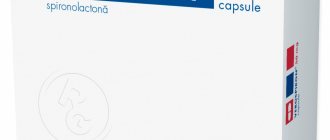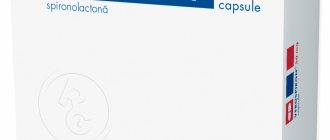Veroshpilakton (Veroshpiron) (caps. 100 mg No. 30)
A country
Russia
The country of production may vary depending on the batch of goods. Please check with the operator for detailed information when confirming your order.
Active substance
Spironolactone
Compound
1 capsule contains: spironolactone 100 mg. Excipients: povidone - 10 mg, lactose monohydrate - 112 mg, potato starch - 82.4 mg, colloidal silicon dioxide (aerosil) - 4 mg, sodium lauryl sulfate - 5.2 mg, talc - 3.2 mg, magnesium stearate - 3.2 mg. Capsules No. 1 with a blue body and cap; the contents of the capsules are white or white powder with a yellowish tint.
pharmachologic effect
Spironolactone is a potassium-sparing diuretic, a specific antagonist of aldosterone (mineralocorticosteroid hormone of the adrenal cortex) with prolonged action. In the distal parts of the nephron, spironolactone prevents the retention of sodium and water by aldosterone and suppresses the potassium-removing effect of aldosterone, reduces the synthesis of permeases in the aldosterone-dependent area of the collecting ducts and distal tubules. By binding to aldosterone receptors, it increases the excretion of sodium, chlorine and water ions in the urine, reduces the excretion of potassium and urea ions, and reduces the acidity of urine. The maximum effect is observed 7 hours after oral administration and lasts for at least 24 hours. The hypotensive effect of the drug is due to the presence of a diuretic effect , which is not permanent: the diuretic effect appears on days 2-5 of treatment.
Indications for use
— essential hypertension (as part of combination therapy); — edematous syndrome in chronic heart failure (can be used in monotherapy and in combination with standard therapy); — conditions in which secondary hyperaldosteronism may be detected, including cirrhosis of the liver, accompanied by ascites and/or edema , nephrotic syndrome, as well as other conditions accompanied by edema; - hypokalemia/hypomagnesemia (as an adjuvant for its prevention during treatment with diuretics and when it is impossible to use other methods of correcting potassium levels); - primary hyperaldosteronism (Conn's syndrome) - for a short preoperative course of treatment; - to establish a diagnosis of primary hyperaldosteronism.
Mode of application
Orally. Essential hypertension The daily dose for adults is usually 50-100 mg once and can be increased to 200 mg, and the dose should be increased gradually, once every 2 weeks. To achieve an adequate response to therapy, the drug must be taken for at least 2 weeks. If necessary, adjust the dose. Idiopathic hyperaldosteronism Prescribed at a dose of 100-400 mg/day. Severe hyperaldosteronism and hypokalemia Prescribed 300 mg/day (maximum 400 mg/day) in 2-3 doses; if the condition improves, the dose is gradually reduced to 25 mg/day. Hypokalemia and/or hypomagnesemia For hypokalemia and/or hypomagnesemia caused by diuretic therapy, the drug is prescribed at a dose of 25-100 mg/day, once or in several doses. The maximum daily dose is 400 mg, if potassium preparations for oral administration or other methods of replenishing its deficiency are ineffective. Diagnosis and treatment of primary hyperaldosteronism As a diagnostic tool for a short diagnostic test: for 4 days, 400 mg / day, divided into several doses per day. If the concentration of potassium in the blood increases while taking the drug and decreases after its discontinuation, the presence of primary hyperaldosteronism can be assumed. For a long-term diagnostic test: at the same dose for 3-4 weeks. When correction of hypokalemia and arterial hypertension is achieved, the presence of primary hyperaldosteronism can be assumed. A short course of preoperative therapy for primary hyperaldosteronism After the diagnosis of hyperaldosteronism is established using more accurate diagnostic methods, Verospilactone should be taken 100-400 mg / day, divided into 1-4 doses during the entire period of preparation for surgery. If surgery is not indicated, then the drug Verospilactone is used for long-term maintenance therapy, using the lowest effective dose, which is selected individually for each patient. Edema due to nephrotic syndrome The daily dose for adults is usually 100-200 mg/day. No effect of spironolactone on the underlying pathological process has been identified, and therefore the use of this drug is recommended only in cases where other types of therapy are ineffective. Edema syndrome due to chronic heart failure Daily, for 5 days, 100-200 mg / day in 2 days 3 doses, in combination with a loop or thiazide diuretic. Depending on the effect, the daily dose is reduced to 25 mg. The maintenance dose is selected individually. The maximum dose is 200 mg/day. Edema due to cirrhosis of the liver. If the ratio of sodium and potassium ions (Na+/K+) in the urine exceeds 1.0, then the daily dose for adults is usually 100 mg. If the ratio is less than 1.0, then the daily dose for adults is usually 200-400 mg. The maintenance dose is selected individually. Edema in children The initial dose in children over 3 years of age is 1-3.3 mg/kg body weight or 30-90 mg/m2/day in 1-4 doses. After 5 days, the dose is adjusted and, if necessary, increased by 3 times compared to the original.
Interaction
Reduces the effect of anticoagulants, indirect anticoagulants (heparin, coumarin derivatives, indandione) and the toxicity of cardiac glycosides (since normalization of potassium levels in the blood prevents the development of toxicity). Enhances the metabolism of phenazone (antipyrine). Reduces the sensitivity of blood vessels to norepinephrine (care is required when carrying out anesthesia), increases T1/2 of digoxin - digoxin intoxication is possible. Increases the toxic effect of lithium due to decreased clearance. Possibly enhances the effect of non-depolarizing muscle relaxants (for example, tubocurarine). Accelerates the metabolism and excretion of carbenoxolone. Carbenoxolone promotes sodium retention by spironolactone. GCS and diuretics ( thiazides and thiazide-like, furosemide, ethacrynic acid) enhance and accelerate the diuretic and natriuretic effects. Enhances the effect of diuretic and antihypertensive drugs. NSAIDs reduce the diuretic and natriuretic effects, increasing the risk of hyperkalemia. Alcohol (ethanol), barbiturates, narcotic substances increase orthostatic hypotension. GCS enhance the diuretic and natriuretic effect in hypoalbuminemia and/or hyponatremia. The risk of developing hyperkalemia increases when taken with potassium preparations, potassium supplements and potassium-sparing diuretics, ACE inhibitors (acidosis), angiotensin II receptor antagonists, aldosterone blockers, indomethacin, cyclosporine. Salicylates, indomet qing reduce the diuretic effect of spironolactone. Ammonium chloride, cholestyramine contribute to the development of hyperkalemic metabolic acidosis. Fludrocortisone causes a paradoxical increase in tubular secretion of potassium. Spironolactone reduces the effect of mitotane. Enhances the effects of triptorelin, buserelin, gonadorelin.
Side effect
From the gastrointestinal tract: nausea, vomiting, diarrhea, ulcerations and bleeding from the gastrointestinal tract, gastritis, intestinal colic, abdominal pain, constipation. From the liver: impaired liver function. From the nervous system: ataxia, lethargy, dizziness, headache pain, drowsiness, lethargy, confusion, muscle spasm. From the blood and lymphatic system: agranulocytosis, thrombocytopenia, megaloblastosis. From laboratory indicators: hyperuricemia, hypercreatininemia, increased urea concentration, water-electrolyte imbalance (hyperkalemia, hyponatremia) and acid - the underlying condition (metabolic hyperchloremic acidosis or alkalosis). From the endocrine system: deepening of the voice, in men - gynecomastia (the likelihood of development depends on the dose, duration of treatment and is usually reversible, and disappears after discontinuation of the drug, and only in rare cases chest gland remains slightly enlarged), decreased potency and erection; in women - menstrual irregularities, dysmenorrhea, amenorrhea, metrorrhagia during menopause, hirsutism, pain in the mammary glands, breast carcinoma (no connection with the drug has been established). Allergic reactions: urticaria, maculopapular and erythematous rash, drug fever, pruritus, eosinophilia, Stevens-Johnson syndrome, toxic epidermal necrolysis. From the skin and subcutaneous tissues: alopecia, hypertrichosis. From the kidneys and urinary tract: acute renal failure. From the musculoskeletal and connective tissue: cramps of the calf muscles From the respiratory system: shortness of breath. If any of the above adverse reactions worsen or other adverse events not listed in the instructions occur, the patient should inform the doctor.
Contraindications
- hypersensitivity to any of the components of the drug; - Addison's disease; - hyperkalemia; - hyponatremia; - severe renal failure (creatinine clearance less than 10 ml/min); - anuria; - pregnancy; - lactation (breastfeeding); - children age up to 3 years (for solid dosage form); - lactase deficiency, lactose intolerance, glucose-galactose malabsorption syndrome (since the drug contains lactose monohydrate). With caution: - hypercalcemia, metabolic acidosis, AV block (hyperkalemia contributes to its strengthening);—diabetes mellitus (with confirmed or suspected chronic renal failure);—diabetic nephropathy;—surgical interventions during anesthesia; taking medications that cause gynecomastia; local and general anesthesia; old age; menstrual irregularities, enlarged mammary glands; liver failure, liver cirrhosis.
Overdose
Symptoms: nausea, vomiting, dizziness, diarrhea, skin rash, hyperkalemia (paresthesia, muscle weakness, arrhythmias), hyponatremia (dry mouth, thirst, drowsiness), hypercalcemia, dehydration, increased urea concentration. Treatment: gastric lavage, symptomatic treatment of dehydration and arterial hypotension. In case of hyperkalemia, it is necessary to normalize the water-electrolyte balance with the help of potassium-removing diuretics, rapid parenteral administration of a 5-20% dextrose (glucose) solution with insulin at the rate of 0.25-0.5 units per 1 g of dextrose (glucose). You can re-enter if necessary. In severe cases, hemodialysis is performed.
special instructions
A temporary increase in serum urea nitrogen is possible, especially with reduced renal function and hyperkalemia. Reversible hyperchloremic metabolic acidosis is possible. In case of impaired renal and hepatic function, as well as in old age, regular monitoring of serum electrolytes and renal function is necessary. The drug makes it difficult to determine digoxin , cortisol and adrenaline in the blood. Despite the lack of a direct effect on carbohydrate metabolism, the presence of diabetes mellitus, especially with diabetic nephropathy, requires special caution due to the possibility of developing hyperkalemia. When treating NSAIDs simultaneously, renal function and electrolyte levels in the blood should be monitored. Avoid eating foods rich in potassium. During treatment, alcohol consumption is contraindicated. Impact on the ability to drive vehicles and operate machinery. During the initial period of treatment, it is prohibited to drive a vehicle and engage in activities that require increased concentration and speed of psychomotor reactions. The duration of restrictions is set individually.
Dispensing conditions in pharmacies
On prescription
Side effects
From the gastrointestinal tract: nausea, vomiting, diarrhea, ulceration and bleeding from the gastrointestinal tract, gastritis, intestinal colic, abdominal pain, constipation.
From the liver: impaired liver function.
From the nervous system: ataxia, lethargy, dizziness, headache, drowsiness, lethargy, confusion, muscle spasm.
From the blood and lymphatic system: agranulocytosis, thrombocytopenia, megaloblastosis.
From laboratory parameters: hyperuricemia, hypercreatininemia, increased urea concentration, disturbance of water and electrolyte balance (hyperkalemia, hyponatremia) and acid-base status (metabolic hyperchloremic acidosis or alkalosis).
From the endocrine system: deepening of the voice, in men - gynecomastia (the likelihood of development depends on the dose, duration of treatment and is usually reversible, and disappears after discontinuation of the drug, and only in rare cases the mammary gland remains slightly enlarged), decreased potency and erection; in women - menstrual irregularities, dysmenorrhea, amenorrhea, metrorrhagia during menopause, hirsutism, pain in the mammary glands, breast carcinoma (no connection with the drug has been established).
Allergic reactions: urticaria, maculopapular and erythematous rash, drug fever, pruritus, eosinophilia, Stevens-Johnson syndrome, toxic epidermal necrolysis.
From the skin and subcutaneous tissues: alopecia, hypertrichosis.
From the kidneys and urinary tract: acute renal failure.
Musculoskeletal and connective tissue disorders: calf muscle cramps.
From the respiratory system: shortness of breath.
If any of the above adverse reactions worsen or other adverse events not listed in the instructions occur, the patient should inform the doctor.


